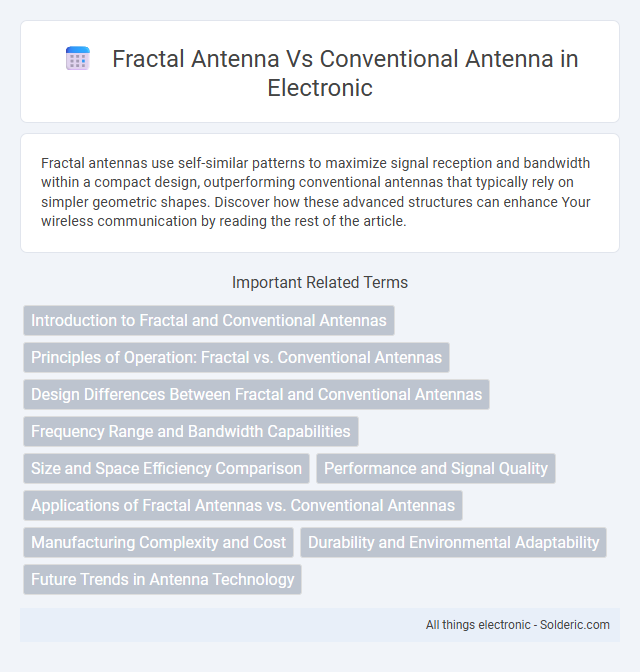Fractal antennas use self-similar patterns to maximize signal reception and bandwidth within a compact design, outperforming conventional antennas that typically rely on simpler geometric shapes. Discover how these advanced structures can enhance Your wireless communication by reading the rest of the article.
Comparison Table
| Feature | Fractal Antenna | Conventional Antenna |
|---|---|---|
| Design | Self-similar geometric patterns | Simple shapes (dipole, monopole) |
| Size | Compact, smaller footprint | Larger, traditional dimensions |
| Frequency Band | Wideband, multiband capabilities | Typically narrowband |
| Performance | Improved bandwidth and gain | Standard bandwidth and gain |
| Efficiency | High efficiency in compact form | Variable efficiency, size-dependent |
| Applications | Mobile devices, wireless, sensing | Broadcasting, radar, traditional comms |
| Manufacturing Complexity | Higher complexity, advanced fabrication | Simple fabrication process |
| Cost | Generally higher due to design | Lower, mature technology |
Introduction to Fractal and Conventional Antennas
Fractal antennas utilize self-similar geometric patterns to achieve compact size and multi-band performance, distinguishing them from conventional antennas that typically rely on simpler, linear designs optimized for single-frequency operation. These fractal designs enhance bandwidth and radiation efficiency by maximizing the effective electrical length within a limited physical space. Your choice between fractal and conventional antennas depends on specific application requirements such as space constraints, frequency versatility, and performance goals.
Principles of Operation: Fractal vs. Conventional Antennas
Fractal antennas operate based on self-similar geometric patterns that enable multi-band and wideband frequency responses by efficiently utilizing space and increasing the effective electrical length. Conventional antennas rely on simple geometric shapes like rods or loops, with resonant frequencies determined by their physical dimensions and straightforward current distribution. The fractal design's iterative nature enhances bandwidth and miniaturization compared to the limited frequency range and size constraints of conventional antennas.
Design Differences Between Fractal and Conventional Antennas
Fractal antennas feature self-similar patterns that optimize space utilization and improve multi-band performance, whereas conventional antennas typically use simpler geometric shapes like rods or loops designed for specific frequencies. The iterative design of fractal antennas enables enhanced compactness and increased effective length within a smaller area, contrasting with the larger, less efficient layouts of conventional antennas. Your choice depends on whether you prioritize size and multi-frequency capabilities, where fractal designs excel, or simplicity and ease of manufacturing, often found in conventional antennas.
Frequency Range and Bandwidth Capabilities
Fractal antennas exhibit enhanced frequency range and multiband capabilities due to their self-similar, recursive geometry, enabling efficient operation across wide and multiple frequency bands. Conventional antennas typically have narrower bandwidth and are often designed for single or limited frequency ranges, restricting their application versatility. The compact design of fractal antennas also supports miniaturization without significant performance loss in bandwidth, making them ideal for modern wireless communication systems.
Size and Space Efficiency Comparison
Fractal antennas offer significant advantages in size and space efficiency compared to conventional antennas by utilizing self-similar, repeating patterns that allow for compact designs without sacrificing performance. Their intricate geometries enable multi-band and wideband capabilities within smaller physical dimensions, making them ideal for applications with limited space. Your devices benefit from enhanced miniaturization and better integration when using fractal antennas, optimizing space without compromising signal quality.
Performance and Signal Quality
Fractal antennas exhibit superior performance and signal quality due to their self-similar design, which enables multiband and wideband capabilities, resulting in enhanced frequency response and reduced signal loss. Conventional antennas typically operate efficiently within a limited frequency range, often requiring larger physical sizes to achieve similar bandwidths. The compact geometry of fractal antennas improves impedance matching and radiation efficiency, leading to better signal clarity and more stable communication links.
Applications of Fractal Antennas vs. Conventional Antennas
Fractal antennas are frequently utilized in compact wireless devices, including smartphones and IoT gadgets, due to their multiband and wideband capabilities, enabling efficient performance across various frequency ranges. Conventional antennas remain predominant in applications requiring high gain and large-scale transmission, such as television broadcasting, satellite communication, and radar systems. The inherent self-similar geometry of fractal antennas offers miniaturization advantages and improved bandwidth, making them ideal for aerospace, military, and medical devices where space and versatility are critical factors.
Manufacturing Complexity and Cost
Fractal antennas feature intricate geometric patterns that increase manufacturing complexity compared to conventional antennas, often requiring advanced fabrication techniques like photolithography or precision etching. This complexity results in higher production costs, especially for large-scale or high-frequency applications. Conventional antennas, with simpler shapes and established manufacturing processes, generally offer lower costs and easier mass production.
Durability and Environmental Adaptability
Fractal antennas exhibit enhanced durability due to their self-similar design, which distributes mechanical stress more evenly, making them less prone to damage compared to conventional antennas. Their complex geometry also allows better environmental adaptability, maintaining reliable performance in extreme temperatures, humidity, and physical obstructions that often degrade traditional antenna function. You benefit from a fractal antenna's resilience and consistent signal quality in harsh environments, ensuring longer lifespan and reduced maintenance costs.
Future Trends in Antenna Technology
Fractal antennas are poised to revolutionize future antenna technology through their multi-band and miniaturization capabilities, outperforming conventional antennas in space efficiency and frequency adaptability. Advances in materials science and 3D printing are enhancing fractal antenna designs, enabling integration into compact, high-performance devices used in 5G, IoT, and satellite communications. Growing demand for flexible, lightweight, and broadband antennas drives ongoing research to optimize fractal geometries, promising significant improvements in wireless communication systems' efficiency and scalability.
fractal antenna vs conventional antenna Infographic

 solderic.com
solderic.com